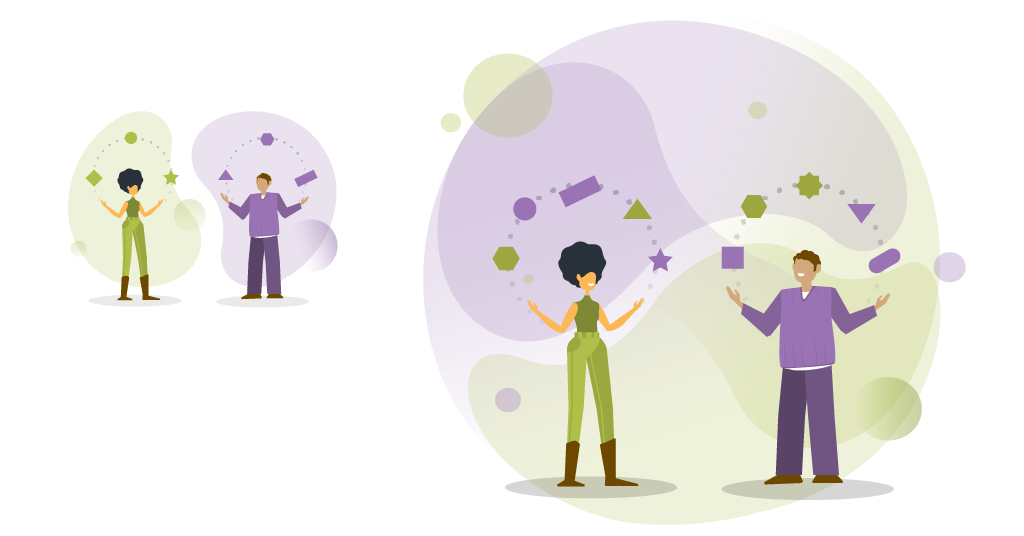A discussion of UX Design and Product Manager roles, best practices for working collaboratively, and the transformative outcomes to be realized
Not long ago, Jesse James Garrett shared his concern over persistent conversations around “the differences between design and product and the antagonisms they sometimes provoke.”
In this post, we –
- Explore the product and design roles, pointing out the differences and embracing the similarities;
- Identify 5 best practices to exploit the tension and avoid the antagonism;
- Realize the transformative outcomes that can result when UX + Product join forces.
Product + Design: 2 Different Roles, 1 Shared Objective
One of the biggest challenges in creating an effective working relationship between designers and product managers is reaching agreement on roles and responsibilities. Historically, the tasks each perform are sufficiently different. So it’s no surprise that product and design roles have been more clearly defined. But as these roles have evolved, their responsibilities offer complex shades of gray – which is where opportunities to collaborate thrive.
Throughout its 25-year history, ITX has partnered with thousands of clients, always seeking the optimal balance and blend of our shared capabilities. In our experience, we see product managers working with clients to realize a vision for the product. Some clients come with their vision already well articulated; others seek help from product strategists to sharpen their focus and gain alignment, commitment, and confidence around their product vision.
Because of the breadth of their perspective, product managers wrestle with tradeoffs that UX designers may not. They see the world through a maze of conflicting lenses – e.g., weighing client expectations against available budget; balancing deadlines and deliverables with scarce resources; and supporting end user workflows while avoiding feature bloat…what Jared Spool refers to as experience rot.
UX design is about solving real problems for real humans. Rich in empathy, designers research, discover, and reflect the concerns, needs, and voice of their end users. From their findings they socialize data and inform decisions for the functional expression of the product vision.
Like their PM counterparts, UX designers have their own dilemmas to navigate. They control for bias and manage assumptions by instilling an evidence-based approach and UX mindset across the entire team. The integration of continuous discovery throughout the development process is a big part of that mindset. Pausing to check back with users or pivoting based on fresh insight combats the risk of tunnel vision that can result from a strict roadmap-release plan focus. Reconciling the needs of users in the wake of stakeholder and schedule demands remains the role of UX design.

5 Tips For Product + Design To Work Collaboratively
Instead of wrangling over blurred territorial lines, we believe the best approach is to discuss openly how best to share these responsibilities. None of this happens automatically. It takes aligning the teams in ways tailored to everyone’s needs and strengths.
- Establish a psychologically safe environment. Trust lies at the foundation of all successful relationships. But trust evaporates in environments where acts of vulnerability – i.e., asking questions, giving feedback, pointing out a mistake – are punished. “Psychological safety,” says Dr. Timothy Clark, “is the great enabler of creativity.”
- Exploit the tension. Bringing product and design (and let’s not forget engineering) onto the same team may feel awkward at first. But if you think that’s awkward, imagine Design going off and unilaterally creating functionality that wasn’t asked for. Or Product hastily delivering an incomplete feature set. Tension is a constraint that drives creativity.
- Share your journey. Abandon the notion that you have all the answers. One of the best ways to build trust is to allow yourself to be vulnerable. Share your work, describe your challenges, and ask for feedback. Initiate a channel to create a free flow of information.
- Eliminate role limitations. Product success is more about what gets done than who does it. Establish a framework that identifies tasks to be completed, assigns responsible parties to execute them, and sets a feedback mechanism for reporting and collaboration.
- Include your engineers. Product development is a team sport. Marty Cagan describes empowered teams as having a product manager, designer, and engineer. “Engineers,” he says, “are working with enabling technology every day. They see what’s possible. But executives, customers, and other stakeholders can imagine only what they can imagine.”
Bringing product, design, and engineering together may put them at odds. But their shared responsibility for product success quickly becomes a forcing function for collaboration, leading to discovery of the optimal solution.
“When a product trio works together to develop a shared understanding of the customer, they are in a much better position to create products that customers love.”

When Product + Design Converge: Transformative Outcomes and Outputs
It’s often said that the product manager carries much of the responsibility for a product’s success, but little of the authority to bring it about.
Product management coach Rich Mironov goes a bit further: “While everyone else has carved out their own place in the organization, the product manager is the person nobody works for. And who, it often seems, works for everybody else.”
As product managers seek to clarify their role, designers want to expand theirs. Jesse James Garrett hears regularly about their desire to do more, to contribute greater value. Standing in the way, he says, is a lack of organizational support and empowerment.
How does the collaboration of product and design advance their respective missions? We believe in the following ways, whether the result of the convergence or the inspiration for it:
- Continued maturation of Product. If product management is to continue its evolution toward strategic leadership, aspiring product leaders will enjoy greater exposure to the user perspective, and will be better positioned to incorporate it into their decisionmaking.
- More expansive role for Design. When design leaders find the empowerment and support they’re after, good product outcomes will follow. But even more than that, their newfound influence will accelerate the structural outcomes that encourage organizations to think differently about the value UX designers bring.
- Cultural transformation within organizations. When Product and Design converge, we see the very real potential for human-centered design to drive human-centered decision-making, which eventually brings about human-centered culture within organizations.
“Imagine an organization that has dialed in its process for understanding its customers and has been executing that process repeatedly for years,” Jesse offers.
“You now have a level of institutional knowledge that hasn’t been possible before,” Jesse concludes. “Which means you now have an organization that operates culturally in different ways; product and design are making different decisions because they have fresh, new awareness of different factors in their decisions.”
Save the Date! ITX’s Product + Design Conference is back! June 22-23 in Rochester, NY. Learn more.

Christina Halladay is a Director of UX Design at ITX. She brings a background in Psychology and a passion for ‘people’ problems, working with distributed cross-functional teams to build impactful, human-centered digital products.

Zake Kane is a Product Strategist at ITX. His commitment to creating digital experiences that solve real-world problems for real people starts with generating alignment, confidence, and commitment around a shared product vision.




